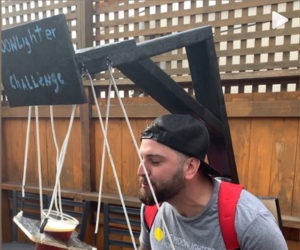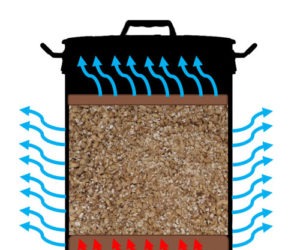Whirlpool Port Install

“I should do this every time!,” I thought. But I sure would look like a schmuck standing there holding the hose in the boil kettle so that it didn’t shoot boiling hot wort all over my brewery. Also, hadn’t I heard something out there about the positive effects of whirlpooling in the kettle? Uh-oh . . . time for another brewery upgrade. A whirlpool port addition to my boil kettle was the solution to my predicament.
My system features a bunch of weldless fittings, inspired by the popular Electric Brewery (www.theelectricbrewery.com) build you can find online. Instead of welding a new port, I’d create one by drilling a hole, and then sealing it with a high-temperature silicone O-ring. This has several benefits. Firstly, I don’t know how to weld. It looks like fun, but I’ve just never learned. Secondly, if I want to adjust, remove, or change out this port later, I can do that. The downside to this approach is that you can never fully sanitize it, as it involves pipe threads. A properly welded, tri-clover port could be sanitized at room temperature, if that’s a requirement for you. That said, it’s going to be in the boil kettle, and I’m going to run boiling wort through it on every brew, meaning I don’t really have to worry about unwanted microbes taking up residence (and living to spoil my beer). This weldless approach has proven popular on the hot side of the brewing process and has been used on every Blichmann Boilermaker kettle for years.
The perfectionist in me loves the idea of a fully welded, tri-clover setup, and those can be had for a reasonable amount of money these days (relatively speaking), complete with whirlpool ports. However, if you are like me and have already dropped a fair amount on your system and you’re looking to step up your end-of-boil capabilities without shelling out for a whole new system or replace all of your hoses, this approach could work well for you.
Tools and Materials
- Step bit (e.g. Greenlee 36414 Multi Hole Step Bit, 1 3⁄8 in.)
- Greenlee 730BB- 13⁄16-in. Standard Round Knockout Punch)
- 5 in. (13 cm) of 1⁄2-in. OD stainless tubing
- 90 degree 1⁄2-in. MPT to 1⁄2–in. compression
- 1⁄2-in. NPT coupler
- 7⁄8-in. ID, 1 3⁄8-in. OD washer
- 1⁄2-in. NPT nipple close
- 1 1⁄8-in. ID, 1 5⁄8-in. OD washer
- 211 Silicone O-Ring 70A Durometer: 13⁄16-in. ID, 11⁄16-in. OD, 1⁄8-in. width
- 1⁄2-in. NPT locknut
- 3-piece ball valve, 1⁄2-in. FPT
- 1⁄2-in. MPT quick disconnect (or whatever connect you use)
- PTFE (Teflon®) tape


